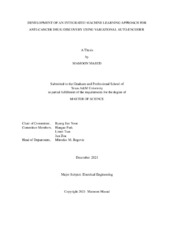| dc.contributor.advisor | Yoon, Byung-Jun | |
| dc.creator | Masud, Mamoon | |
| dc.date.accessioned | 2022-07-27T16:43:43Z | |
| dc.date.available | 2023-12-01T09:23:14Z | |
| dc.date.created | 2021-12 | |
| dc.date.issued | 2021-12-07 | |
| dc.date.submitted | December 2021 | |
| dc.identifier.uri | https://hdl.handle.net/1969.1/196383 | |
| dc.description.abstract | Cancer is one of the leading causes of death across the world and accounted for almost 10
million deaths in the year 2020 alone. Anti-cancer drug discovery & response prediction is an
arduous and time-consuming process. This work investigates the use of generative models to
predict anti-cancer drug response and facilitate the discovery of new drugs, utilizing chemical
structure of drugs, gene expression data and response data of anti-cancer drugs.
Autoencoders are a type of neural network that are trained to learn a lower dimensional representation of a high dimensional data, while a Variational Autoencoder (VAE) is trained to model the data as a distribution over the latent space. The proposed approach models the anti-cancer drug molecular data using a rectified junction tree VAE (JTVAE) model while the cancer cell lines’ gene expression data is encoded using a VAE. A feed-forward artificial neural network takes in the concatenated encoded latent vectors of gene expression profile for a cancer cell line and latent vectors of drugs to generate a final prediction, represented by the ln(IC₅₀) score. The model was trained on three different datasets, with one set consisting of breast cancer cell lines, another of central nervous system cell lines and one consisting of pan-cancer cell lines. Testing on pan-cancer cell lines produced a high average coefficient of determination (R2 = 0.875), and it was the best performing model.
Additionally, this work has investigated the optimizing the latent space using weighted retraining. This was done to improve the sample efficiency. The technique adopted was sample efficient and weighted data points based on the blood brain barrier permeability. A Message Passing Neural Network (MPNN) based predictor was trained to predict blood brain barrier permeability score in the input data. After training the generative model (JTVAE), the objective function was optimized over the learned latent space using a surrogate model. This decoupled the tasks of training the generative model, and optimizing it. Weighting the data distribution, and periodic retraining of the generative model improved the prediction score of Blood Brain Barrier permeability, which is an important factor for drugs that are targeted at Central Nervous Systems tumours. | |
| dc.format.mimetype | application/pdf | |
| dc.language.iso | en | |
| dc.subject | Variational Auto-Encoder | |
| dc.subject | Cancer Drug Response | |
| dc.subject | Generative Models | |
| dc.subject | Anti-Cancer Drug Discovery | |
| dc.subject | Latent Space Optimization | |
| dc.title | Development of an Integrated Machine Learning Approach for Anti-Cancer Drug Discovery Using Variational Auto-Encoder | |
| dc.type | Thesis | |
| thesis.degree.department | Electrical and Computer Engineering | |
| thesis.degree.discipline | Electrical Engineering | |
| thesis.degree.grantor | Texas A&M University | |
| thesis.degree.name | Master of Science | |
| thesis.degree.level | Masters | |
| dc.contributor.committeeMember | Park, Hangue | |
| dc.contributor.committeeMember | Zou, Jun | |
| dc.contributor.committeeMember | Tian, Limei | |
| dc.type.material | text | |
| dc.date.updated | 2022-07-27T16:43:43Z | |
| local.embargo.terms | 2023-12-01 | |
| local.etdauthor.orcid | 0000-0002-1614-4346 | |


